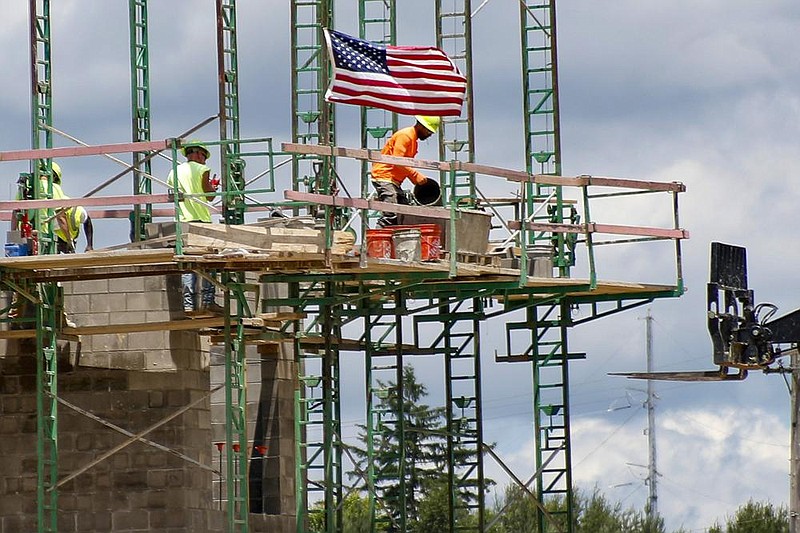SILVER SPRING, Md. -- U.S. productivity rose at a 7.3% rate in the second quarter as the number of hours worked fell by nearly half, the biggest drop-off since the government started tracking the data more than 70 years ago.
The Labor Department said Friday that output decreased 38.9%, also the biggest decline ever recorded as hours worked fell 43%, with the coronavirus pandemic sowing economic damage throughout the U.S.
The increase in productivity was the largest since 2009. Labor costs also jumped, rising 12.2%.
Friday's report is the first estimate of second-quarter productivity and follows the first quarter's 0.3% decline. The rise in labor costs, the largest since 2014, follows a 9.8% increase in the January-March quarter.
Defined as the amount of output per hour of work, productivity is the key to rising living standards, and the slow pace of growth in recent years has been a major reason wage gains have stalled. Productivity mostly lagged during the record-long 11-year expansion that followed the previous recession, confounding economists.
[CORONAVIRUS: Click here for our complete coverage » arkansasonline.com/coronavirus]
From a year earlier, productivity rose 2.2%. Unit labor costs increased 5.7% year-over-year. The report also showed inflation-adjusted hourly compensation rose at a 24.8% annual pace during the quarter after an 8.1% increase.
From 2000 to 2007, the year the last recession began, annual productivity gains averaged 2.7%. But since then, productivity has slowed to about half that pace, rising at an average annual rate of 1.4% from 2007 through 2019. The 2019 rate of 1.9% brought some optimism that productivity was on the rise, but the coronavirus pandemic hit in the first quarter of 2020, obliterating the economy and taking virtually every economic indicator down with it.
Economists have warned that the economic disruptions caused by the coronavirus would likely hinder productivity in coming quarters.
Last month, the government reported an astonishing 32.9% plunge in second-quarter gross domestic product, the value of goods the country produced in the April-June quarter. It was the sharpest such drop on records dating to 1947, and almost entirely related to the fallout from the coronavirus pandemic, which has shuttered business temporarily and permanently, sending millions of workers to the unemployment line.
The Trump administration has predicted a third quarter economic rebound, but many economists think the economy can't fully recover until the virus is mostly defeated.
The government will issue a second productivity estimate next month.
In a separate report Friday, the Federal Reserve reported that industrial production -- including output at factories, mines and utilities -- climbed 3% in July after surging 5.7% in June. Still, production remains 8.4% below its level in February before the outbreak began to spread rapidly in the United States.
Factory output rose 3.4% last month, pulled higher by a 28.3% gain in production of cars, trucks and auto parts.
The Fed's report showed utility output increased 3.3%, while mining rose 0.8%, the first advance since January. Oil and gas well drilling fell another 8% after an 18% drop a month earlier. Drilling has plummeted 71.5% from a year earlier after a slump in oil prices month ago prompted exploration and production companies to slash projects.
Industry was running at 70.6% of capacity, up from its April low of 64.2% but well below its long-term (1972-2019) average of 79.8%. The utilization rate remains well below the 75% that prevailed before the virus took hold.
Excess capacity weighs on corporate profits because capital is underutilized and it also signals business investment in new equipment will remain depressed and weigh on economic growth.
The coronavirus, the lockdowns meant to contain it, and the wariness of consumers and businesses in a health crisis hammered American industry this spring. Overall output retreated at a 43.2% annual rate from April through June, the biggest drop since the demobilization that followed World War II.
Industrial production has now risen three straight months as the U.S. economy began to reopen after being locked down in the spring, but a resurgence of coronavirus infections in July has raised doubts about whether the economy's comeback is sustainable.
"The level of activity is still subdued," Rubeela Farooqi, chief U.S. economist at High Frequency Economics, wrote in a research report. "Output was boosted by a fuller reopening in July but weak demand and virus outbreaks that can interrupt activity remain a threat going forward."
Information for this article was contributed by Matt Ott and Paul Wiseman of The Associated Press and by Olivia Rockeman, Maeve Sheehey and Vince Golle of Bloomberg News.
